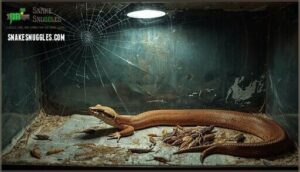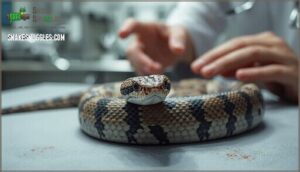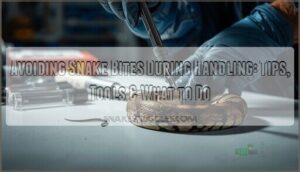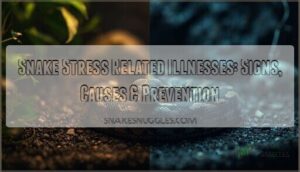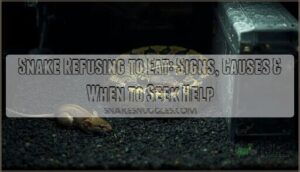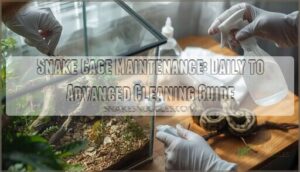This site is supported by our readers. We may earn a commission, at no cost to you, if you purchase through links.
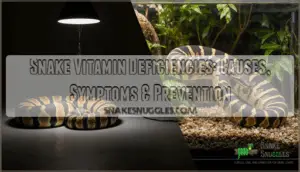
Your snake depends entirely on you to provide the vitamins and minerals it can’t produce on its own, yet many common feeding practices create dangerous nutritional gaps.
Understanding which deficiencies affect snakes, what causes them, and how to spot the warning signs early can mean the difference between a thriving reptile and one facing irreversible organ damage.
Table Of Contents
- Key Takeaways
- Common Vitamin Deficiencies in Snakes
- Causes of Vitamin Deficiencies in Snakes
- Symptoms of Vitamin Deficiencies in Snakes
- Diagnosing Vitamin Deficiencies in Snakes
- Preventing and Treating Vitamin Deficiencies
- Frequently Asked Questions (FAQs)
- Do snakes have a vitamin deficiency?
- Do snakes have a zinc deficiency?
- How do you know if a reptile has a vitamin A deficiency?
- Do snakes need vitamin C?
- What happens if a snake eats a vitamin D3 deficiency?
- Do snakes need vitamin D?
- How often should I replace my snakes UVB bulb?
- Can vitamin deficiencies be reversed with dietary changes alone?
- What blood tests detect vitamin deficiencies in snakes?
- Are liquid or powder vitamin supplements more effective?
- Conclusion
Key Takeaways
- Vitamin A, D3, E, and B-vitamin deficiencies develop silently over months of improper feeding and lack of UVB exposure, causing eye swelling, poor shedding, bone weakness, and neurological problems that become irreversible if left untreated.
- Most deficiencies stem from three preventable mistakes: feeding low-quality or limited prey types, skipping UVB lighting, and using inconsistent or incorrect supplementation practices.
- Early warning signs like cloudy eyes, rough incomplete sheds, and muscle weakness catch problems before they cause permanent damage—regular visual checks and monthly vet exams are your best defense.
- Species-appropriate whole prey diets, proper UVB bulbs replaced every 6-12 months, consistent calcium and vitamin supplementation, and detailed feeding records prevent 90% of nutritional deficiencies in captive snakes.
Common Vitamin Deficiencies in Snakes
Snakes can develop several vitamin deficiencies that impact their health in different ways. Each deficiency creates its own set of problems, from skin and eye issues to bone weakness and neurological symptoms.
Let’s look at the most common vitamin deficiencies you’ll want to watch for in your snake.
Vitamin a Deficiency
Of all the vitamin deficiencies affecting captive snakes, Hypovitaminosis A stands out as particularly common in turtles and snakes fed inadequate diets. You’ll notice symptoms progressing from swollen eyelids and mucus buildup to serious complications:
- Squamous metaplasia and glandular degeneration damage respiratory and digestive tracts, causing nasal discharge and skin ulcers
- Retinol levels plummet below 0.05 mg/mL, signaling biochemical deficiency that demands immediate attention
- Neurological signs emerge—ataxia symptoms, muscle tremors, and torticollis warn of advancing vitamin A deficiency
Without treatment, blindness risk becomes reality as corneal inflammation worsens and eye tissue deteriorates. This condition is often seen in insectivorous lizard species.
Vitamin D3 Deficiency
While vitamin A affects soft tissues, calcium absorption depends on adequate vitamin D3—and that’s where many indoor snakes run into trouble. Without proper UVB lighting, your snake can’t synthesize vitamin D, leading to soft bones, fractures, and metabolic bone disease. You’ll see swollen limbs, difficulty moving, and even neurological signs like tremors.
Though less common in snakes than lizards (since whole prey contains some vitamin D3), captive snakes housed indoors remain vulnerable without UVB exposure or dietary sources rich in this essential nutrient. A common issue is nutritional secondary hyperparathyroidism caused by calcium and phosphorus imbalance.
Vitamin E Deficiency
Another often-overlooked issue is vitamin E deficiency, which hits captive snakes fed diets heavy in processed or stored prey. When vitamin E breaks down in old food—especially oily fish—your snake faces steatitis risk and muscle degeneration that can spiral quickly.
Watch for these warning signs:
- Anorexia and lingual ulcerations
- Muscle tremors and neurological impacts like ataxia or torticollis
- Cardiac issues leading to cardiomyopathy
- Fat necrosis causing painful inflammation
Diet quality matters enormously here, as malnutrition from vitamin E deficiency affects everything from heart function to basic movement, underscoring why snake nutritional requirements demand fresh, properly stored prey.
B Vitamin Deficiencies
If vitamin E troubles weren’t enough, B vitamin deficiencies—especially thiamine deficiency (hypovitaminosis B1)—create serious neurological symptoms in piscivorous snakes like garter and water snakes.
Dietary thiaminases in certain fish destroy thiamine, triggering muscle twitching, seizures, torticollis, and even death.
Snake nutritional requirements demand B-vitamin supplementation when feeding fish-heavy diets to prevent these devastating outcomes.
Calcium and Phosphorus Imbalances
Beyond individual vitamins, Calcium Balance and Phosphorus Levels dictate Bone Health in profound ways. When Dietary Ratios fall below the ideal Calcium to Phosphorus Ratio of 2:1—or when UVB Importance goes unrecognized—you’ll see Nutritional Secondary Hyperparathyroidism develop. This triggers MBD Symptoms like rubber jaw, fractures, and tremors.
Renal Disease compounds these Nutrient Ratios issues, making mineral homeostasis even trickier to maintain.
Causes of Vitamin Deficiencies in Snakes
Vitamin deficiencies in snakes don’t happen by accident. They’re the result of specific husbandry mistakes that add up over time.
Vitamin deficiencies in snakes stem from preventable husbandry mistakes that accumulate over time
Let’s look at the main factors that put your snake at risk.
Inadequate Diet and Prey Choices
Your snake’s diet is like building a house—if the foundation’s shaky, everything crumbles. Poor prey quality, limited diet variety, and improper prey size create nutritional imbalances that starve your snake of essential vitamins.
Feeding only mice to species needing varied feeder prey leads to vitamin A, D3, and E deficiencies.
Nutritionally inadequate or poorly supplemented prey, especially organ meat dangers from obese frozen rats, degrades vitamin content and triggers multiple deficiencies affecting your snake’s health.
Lack of UVB Exposure
Without UVB light, your snake can’t produce vitamin D3, which unlocks calcium absorption and keeps bones strong. Studies show UVB exposure greatly boosts vitamin D3 levels in snakes, preventing metabolic bone disease. Aim for a UV index of 1.0 to 2.0 using appropriate UVB bulb types at proper distances.
Seasonal variations matter too—wild snakes naturally adjust, but captive snakes need consistent lighting year-round to maintain healthy D3 synthesis rates.
Poor Gut-Loading Practices
You know that old saying—you’re what you eat? Well, your snake is what its prey ate. Feeder insects or prey items that aren’t properly gutloaded deliver far fewer nutrients, especially calcium and vitamin A. Here’s what sabotages nutrient transfer:
- Feeding insects immediately after purchase without giving them time to eat enriched foods
- Using low-calcium vegetables like lettuce instead of nutrient-dense options for gut-loading
- Short gut-load duration—less than 24 hours often doesn’t allow enough calcium enrichment
- Inconsistent methods that vary the quality of gutloaded insects from feeding to feeding
- Poor insect quality from suppliers who don’t maintain healthy feeder colonies
When your snake diet relies on under-prepared prey items during snake feeding, deficiencies follow.
Improper Supplementation
Too much supplementation can be just as dangerous as too little. Over-supplementation risks include vitamin D3 toxicity, which causes hypercalcemia and organ damage. Inadequate supplementation leaves snakes vulnerable to deficiencies like hypovitaminosis A, leading to eye swelling and skin issues.
Supplement quality matters—expired or improperly stored products lose potency. Dosing accuracy is critical; inconsistent vitamin supplementation disrupts snake nutrition. Supplement interactions can also interfere with absorption, complicating snake health management.
Symptoms of Vitamin Deficiencies in Snakes
When something’s off with your snake’s nutrition, their body sends clear signals that something needs attention. Vitamin deficiencies show up in predictable ways, from visible changes in skin and scales to subtle shifts in behavior that are easy to miss if you’re not watching closely.
Here’s what to watch for so you can catch problems early and keep your snake healthy.
Shedding and Skin Problems
When your snake struggles with shedding, it’s often waving a red flag about vitamin deficiencies and malnutrition impact. Approximately 29% to 64% of skin problems in snakes stem from nutritional deficiencies, making proper snake nutrition critical for healthy skin conditions. Dysecdysis causes include deficiencies in vitamins A, D, and E, while rare Vitamin C shortages can lead to thin, easily torn skin.
Watch for these snake shedding warning signs:
- Skin comes off in multiple pieces instead of one complete shed
- Dull, dry appearance with scale discoloration or abnormal development
- Skin lesions appearing on new growth areas
- Retained skin stuck around body sections
- Over half of nutritional skin cases show mild severity, but 34% progress to moderate issues
Vitamin deficiencies disrupt the natural shedding process, transforming what should take hours into a prolonged struggle that compromises your snake’s health and comfort.
Eye Swelling and Retained Eyecaps
While skin problems signal trouble, vitamin A deficiency hits your snake’s eyes hard. Up to 40% of poorly nourished captive snakes develop ocular infections, swelling, and conjunctivitis. Retained eyecaps—where skin stays stuck around the eyes—affect 20-35% of snakes with vitamin A deficiency. You’ll notice spectacle retention during failed sheds, often alongside other skin problems. Corneal damage can follow if left untreated.
Treatment costs range from $150 to $400 per case, but vitamin A supplementation reduces these ocular diseases by 60%.
Skeletal and Muscular Issues
Vitamin D3 deficiency drives up to 70% of skeletal issues, causing metabolic bone disease with bone deformities and muscle weakness. You’ll spot muscle wasting, abnormal postures, and fractures in severe cases. Vitamin E deficiency triggers muscle degeneration in 30-50% of snakes on poorly supplemented diets. Calcium deficiencies worsen bone health, creating a cascade of problems. Treatment costs run $200-$500 per case, but proper dietary D3 and UVB lighting prevent most skeletal deformities.
- Soft, rubbery jawbones that bend under gentle pressure
- Trembling limbs unable to support your snake’s body weight
- Spinal kinks and rib fractures from routine handling
Neurological and Behavioral Changes
Beyond muscle and bone problems, neurological symptoms signal serious vitamin deficiencies. Thiamine deficiency triggers ataxia and tremors in up to 70% of affected snakes, with seizure prevalence reaching 30-60% depending on diet quality. Vitamin A deficiency causes blindness and posture abnormalities in 20-40% of captive snakes.
You’ll notice unusual head tilts, muscle twitching, or coordination loss—behavioral changes due to malnutrition that shouldn’t be ignored.
Environmental enrichment effects show these neurological issues decrease 50% with proper nutrition.
Poor Growth and Reproductive Problems
Deficiencies don’t just cause immediate problems—they compromise growth rate and breeding success over time. Vitamin D deficiency keeps plasma levels below 46 ng/mL in most captive snakes, impairing hatchling health and egg production. Calcium shortages make dams 9.2 times more likely to experience egg binding, a life-threatening reproductive problem.
You’ll see stunted growth, infertile eggs, and poor breeding outcomes when dietary impact goes unchecked. Balanced nutrition reduces these reproductive problems by 50%.
Diagnosing Vitamin Deficiencies in Snakes
Catching a vitamin deficiency early can make all the difference in your snake’s recovery. You’ll need to combine your own careful observations with professional veterinary expertise to get an accurate diagnosis.
Here’s how to identify and confirm nutritional problems before they become serious.
Visual Health Assessments
You can’t assess your snake’s health without a regular visual check—think of it as reading your pet’s daily report card. Monthly examinations help you spot ocular abnormalities like swollen eyes or retained eyecaps, shedding issues, and changes in scale condition before they escalate.
Look for shifts in body shape, skin integrity problems like dullness or tears, and any physical appearance changes that signal deficiency. Systematic snake care catches symptoms early, protecting your snake’s long-term health.
Recognizing Early Warning Signs
What subtle changes signal trouble before obvious symptoms appear? Watch for dermal irregularities like dull, rough scales or incomplete shedding—early warning signs of vitamin deficiencies that demand immediate attention.
Ocular indicators such as cloudy eyes or slight eye discharge, mucosal signs like dry mouth tissue, and behavioral shifts including activity reduction or decreased basking all point to developing nutritional problems.
Catching these symptoms early protects your snake’s health and prevents permanent damage.
Veterinary Diagnostic Techniques
When subtle symptoms require confirmation, your veterinarian employs precise diagnostic approaches. Plasma analysis through blood tests measures vitamin D3 levels and calcium-phosphorus ratios. Imaging modalities like radiographs detect metabolic bone disease, while ultrasound examination reveals soft tissue swelling from vitamin A deficiency.
Fecal exams identify parasites blocking nutrient absorption. Histopathology confirms tissue damage, and therapeutic trials with targeted supplementation verify suspected deficiencies when clinical improvements follow treatment.
Monitoring Dietary History
Your detailed records of prey type, size, and feeding frequency serve as a diagnostic roadmap when deficiencies emerge. Document each meal using log books, spreadsheets, or specialized apps—approximately 20-50% of dedicated snake keepers maintain these essential records.
Track prey parameters like species, weight, and gut-loading practices, since poorly nourished prey directly causes vitamin and mineral deficiencies in 30-50% of cases. Consistent record-keeping allows early detection of nutritional gaps, supporting both prevention and veterinary diagnosis.
Preventing and Treating Vitamin Deficiencies
Prevention is always easier than treatment for vitamin deficiencies in snakes. You’ll need to focus on a few key areas to keep your snake healthy and avoid nutritional problems.
Let’s look at the main strategies that’ll help you prevent deficiencies before they start and know when professional help is necessary.
Species-Appropriate Diet Planning
You can’t just toss any prey item at your snake and hope for the best—species-appropriate diets matter. Your snake species determines whether you’ll offer mice, rats, chicks, or fish.
Gut loading prey items 24-48 hours before feeding boosts calcium and vitamin A content by up to 50%. Match prey size to 1-1.5 times your snake’s widest part, and adjust feeding frequency based on age: juveniles need meals every 5-7 days, while adults thrive on 7-14 day schedules.
Proper snake nutrition starts with understanding supplementation needs specific to your snake diet and feeding routine.
Importance of UVB Lighting
UVB lighting isn’t optional—it’s the cornerstone of vitamin D3 synthesis in snakes. When UVB rays hit your snake’s skin, they convert 7-dehydrocholesterol into vitamin D3, which drives calcium absorption and prevents metabolic bone disease.
Key UVB setup essentials:
- Lamp selection: T5 HO fluorescent tubes or mercury vapor bulbs deliver ideal UVB output for most species
- Placement distance: Position lamps 16-20 inches from basking areas to achieve proper UVI levels (0.1-1.0 for terrestrial snakes, 1.0-3.0 for basking species)
- Replacement schedule: Replace bulbs every 6-12 months to maintain effective UVB emission
Proper UVB lighting triggers natural basking behavior, boosts appetite, and promotes skeletal health—benefits you’ll notice in your snake’s activity level and overall vitality.
Correct Supplementation Practices
Supplementation bridges dietary gaps UVB lighting can’t fill. Dust prey with calcium powder containing at least 8-10% calcium 2-3 times weekly, maintaining a 2:1 calcium-to-phosphorus ratio. Add multivitamin supplementation weekly, rotating vitamin D3 supplementation based on UVB access—snakes without adequate exposure need 500-1000 IU/kg every 7-10 days.
Gut-loading feeder insects and rodents for 24-48 hours before feeding enhances their nutritional profile with calcium, vitamin A, and essential fatty acids, maximizing nutrient transfer with every meal.
Regular Health Monitoring
Once you’ve nailed supplementation, staying on top of snake health means checking in regularly—think of it as preventive maintenance for your scaly friend. Schedule physical exams with your vet at least annually, but don’t wait for appointments to spot trouble.
Environmental monitoring catches problems like incorrect temps or humidity that trigger deficiencies. Watch behavioral indicators like lethargy or appetite changes, weigh your snake monthly for weight monitoring, and keep health records tracking shedding cycles and feeding patterns.
This approach aids early detection of reptile health issues before they become serious, giving you the upper hand in maintaining peak snake health through proactive veterinary care.
When to Seek Veterinary Care
Even with monthly health checks, some symptoms demand immediate action. Urgent symptoms like sudden weakness, inability to move, respiratory distress, or severe ocular problems such as swollen eyes mean you can’t wait—contact a reptile veterinarian right away.
Home treatment carries potential risks, including misdiagnosis or over-supplementation toxicity, which can worsen animal health.
If your snake shows persistent lethargy, abnormal shedding, skeletal deformities, or neurological changes in snake behavior, professional care prevents irreversible damage from severe illness.
Frequently Asked Questions (FAQs)
Do snakes have a vitamin deficiency?
Yes, vitamin deficiencies in snakes are like cracks in a foundation—small issues can become major problems. Deficiency prevalence varies by captivity conditions, but poor dietary needs and inadequate supplementation commonly create health implications.
Malnutrition from improper snake husbandry triggers diseases affecting growth, immunity, and neurological function. Supplement efficacy depends on correct feeding practices and UVB exposure.
Do snakes have a zinc deficiency?
Zinc deficiency in snakes is rare and poorly documented in scientific literature, likely because their natural diet generally provides adequate zinc absorption. However, improper feeding—such as relying on oily fish or unbalanced diets—can disrupt mineral balance.
Watch for poor shedding, skin lesions, or reproductive issues as potential signs.
Promote dietary variety, proper gut-loading, and veterinary oversight to maintain your snake’s zinc functions and overall health.
How do you know if a reptile has a vitamin A deficiency?
Your snake’s swollen eyelids and difficulty shedding signal trouble. Watch for crusty eyes, oral sores, and visual impairment—classic warning signs of vitamin A deficiency.
Retained eyecaps, rough hyperkeratosis on skin, and corneal inflammation demand veterinary attention.
A serum retinol blood test confirms diagnosis.
Do snakes need vitamin C?
Your snakes don’t need dietary vitamin C. They synthesize it internally through their kidneys and intestines, maintaining adequate levels without supplementation. Most prey animals contain minimal vitamin C anyway.
Focus instead on providing appropriate nutrition, proper UVB lighting, and monitoring for deficiency symptoms like poor skin health or immune issues, which generally signal malnutrition rather than vitamin C deficiency alone.
What happens if a snake eats a vitamin D3 deficiency?
Here’s the uncomfortable truth: when your snake doesn’t get enough vitamin D3, its body can’t absorb calcium properly, triggering a cascade of problems.
Without adequate D3 absorption, calcium imbalances develop, leading to bone deformities, neurological issues like tremors and weakness, and increased mortality risk if left untreated.
Do snakes need vitamin D?
Yes, your snake absolutely needs vitamin D. It’s essential for calcium absorption and bone health, preventing metabolic bone disease.
Your snake can synthesize D3 through UVB exposure or get it from dietary sources. Proper UVB lighting and varied prey are critical for maintaining adequate levels.
How often should I replace my snakes UVB bulb?
Picture a bulb glowing steadily in your enclosure—but its power fades invisibly over time. Replace UVB bulbs every 6 to 12 months, depending on type. T8 fluorescent bulbs need replacement around 6 months; T5 bulbs last roughly 12 months. Mercury vapor bulbs usually require replacement every 6 to 12 months.
Even if the bulb looks fine, its UVB output drops considerably after 6 months, reducing your snake’s ability to synthesize vitamin D Consider testing with a radiometer to verify actual output.
Proper fixture design and quality ballasts extend bulb life, but regular replacement prevents metabolic bone disease and keeps your snake healthy.
Can vitamin deficiencies be reversed with dietary changes alone?
Many vitamin deficiencies can be reversed through dietary changes alone, especially when caught early. Switching to species-appropriate whole prey diets and adding targeted supplementation usually restores health within 1-3 months.
However, severe cases with tissue damage often require injectable vitamins and environmental modifications beyond diet to accelerate recovery.
What blood tests detect vitamin deficiencies in snakes?
Blood tests reveal what your snake’s body is telling you. Retinol biomarkers and 25(OH)D levels show vitamin A and D3 status.
Calcium and phosphorus testing, including the Ca:P ratio, detect mineral imbalances linked to metabolic bone disease.
Your veterinarian uses these markers to diagnose deficiencies and guide treatment.
Are liquid or powder vitamin supplements more effective?
Liquid supplements generally outperform powders for snakes because they require less digestion, achieving absorption rates between 55% and 99%—especially in oil-based or micellized forms.
Powders need mixing, risking dosing inconsistency and faster degradation.
For precise administration and bioavailability, liquid formulations deliver enhanced nutritional support.
Conclusion
Your snake’s health hinges on one silent reality: nutritional deficiencies don’t announce themselves until damage is done. By the time cloudy eyes appear or shedding fails, months of inadequate care have already taken their toll.
Snake vitamin deficiencies are entirely preventable through species-appropriate diets, proper supplementation, and UVB exposure.
The path forward is straightforward—feed thoughtfully, supplement wisely, and monitor consistently. Your vigilance today protects your snake’s tomorrow.
- https://pmc.ncbi.nlm.nih.gov/articles/PMC11591334
- https://www.vettimes.com/clinical/equine/common-nutritional-disorders-of-captive-reptiles-cpdreptiles
- https://veterinarypartner.vin.com/default.aspx?pid=19239&catId=102919&id=8017945
- https://veterinaryvisioncenter.com/vitamin-a-deficiency-in-pet-reptiles
- https://wpvet.com/reptile-rounds/hypovitaminosis-a

